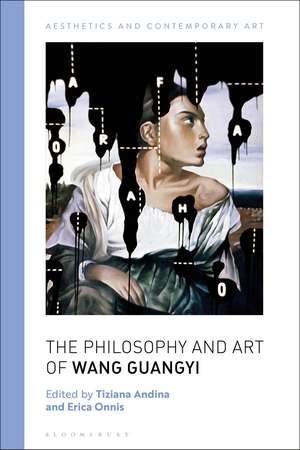The Philosophy and Art of Wang Guangyi: Aesthetics and Contemporary Art
Editat de Tiziana Andina, Erica Onnisen Limba Engleză Hardback – 12 iun 2019
| Toate formatele și edițiile | Preț | Express |
|---|---|---|
| Paperback (1) | 219.19 lei 43-57 zile | |
| Bloomsbury Publishing – 23 dec 2020 | 219.19 lei 43-57 zile | |
| Hardback (1) | 657.70 lei 22-36 zile | |
| Bloomsbury Publishing – 12 iun 2019 | 657.70 lei 22-36 zile |
Preț: 657.70 lei
Preț vechi: 943.82 lei
-30% Nou
Puncte Express: 987
Preț estimativ în valută:
125.85€ • 131.75$ • 104.13£
125.85€ • 131.75$ • 104.13£
Carte disponibilă
Livrare economică 17-31 martie
Preluare comenzi: 021 569.72.76
Specificații
ISBN-13: 9781350019379
ISBN-10: 1350019372
Pagini: 296
Dimensiuni: 156 x 234 mm
Greutate: 0.57 kg
Editura: Bloomsbury Publishing
Colecția Bloomsbury Academic
Seria Aesthetics and Contemporary Art
Locul publicării:London, United Kingdom
ISBN-10: 1350019372
Pagini: 296
Dimensiuni: 156 x 234 mm
Greutate: 0.57 kg
Editura: Bloomsbury Publishing
Colecția Bloomsbury Academic
Seria Aesthetics and Contemporary Art
Locul publicării:London, United Kingdom
Caracteristici
Brings together well-known scholars in philosophy of art to discuss the impact and aesthetics of Wang's Guangyi work
Notă biografică
Tiziana Andina is Associate Professor of Philosophy at the University of Turin, Italy.Erica Onnis is a PhD student in theoretical philosophy at the University of Turin, Italy, where since 2015, she is a member of the Labont - Center for Ontology.
Cuprins
List of FiguresNotes on ContributorsIntroduction: Chinese Contemporary Art: Between Deconstruction and Construction, Tiziana Andina and Erica Onnis 1. Defining the Human and Humanizing the DivineGratings, Barriers and Boundaries. Wang Guangyi's Transcendental Painting, Luca IlletteratiWang Guangyi. Popular Study on Anthropology, Demetrio Paparoni 2. Duplicating the SceneWang Guangyi's "Material Spirit": a Religion Embodied in Art, Tiziana AndinaThe Tears of Pictures. Duplication and Inflection in Wang Guangyi's Oeuvre, Enrico Terrone 3. Bridging the Cultural Divide Through PopOn the Meanings of Propaganda, Erica OnnisA Critique of Wang Guangyi's "Great Criticism: Coca Cola", Xian Zhou 4. Words and Images: Two Instruments to Describe the WorldWang Guangyi and the Culture of the Cover: on Contemporary Pop Art and Political Theology, Babette BabichThe Globalist Dimension of Art. Wang Guangyi and Transculturalism, Davide Dal Sasso 5. Erasing the EmotionsGrief and the Power of the Mind, Carola BarberoThinking with Idols. A Conversation with Wang Guangyi, Andrew Cohen 6. The Circle of Life: Presenting and Representing Food.Food Art, A Hymn to Nature, Mary Bittner WisemanFood in Wang Guangyi's Art, Nicola Perullo 7. In Dialogue with Wang GuangyiNothingness, God, the Soul and the World. A Conversation with Wang Guangyi, Demetrio PaparoniDark Learning, Mysticism and Art. A Conversation with Wang Guangyi, Yan Shanchun Index
Recenzii
Wang Guangyi is the most significant painter to have emerged out of the 1980s encounter between Western and Chinese postmodernisms. This volume's essays and interviews --adeptly traversing conventional boundaries of art criticism, philosophy, history, and political theory-comprise the most significant treatment in English of Guangyi's ironic, intellectual, cool, subversive, and yet wildly popular art. And more generally, the book makes vivid how Chinese contemporary art, despite deploying seemingly similar aesthetic strategies to those found in the West, developed out of substantially sui generis concerns.
By focusing on Wang Guangyi, a trendsetter in contemporary Chinese art since the mid-1980s, this original volume presents a variety of angles to rethink many key concepts and visual strategies in contemporary art across the East-West divide. In so doing it provides an unusually detailed and sensitive analysis of an important artist as well as a possible model for transregional and interdisciplinary studies on global contemporary art.
By focusing on Wang Guangyi, a trendsetter in contemporary Chinese art since the mid-1980s, this original volume presents a variety of angles to rethink many key concepts and visual strategies in contemporary art across the East-West divide. In so doing it provides an unusually detailed and sensitive analysis of an important artist as well as a possible model for transregional and interdisciplinary studies on global contemporary art.













